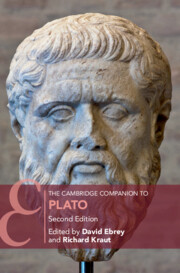Book contents
- The Cambridge Companion to Plato
- Other Volumes in the Series of Cambridge Companions
- The Cambridge Companion to Plato
- Copyright page
- Contents
- Contributors
- Acknowledgments
- Chronology
- Abbreviations
- 1 Introduction to the Study of Plato
- 2 Plato in his Context
- 3 Stylometry and Chronology
- 4 Plato’s Socrates and his Conception of Philosophy
- 5 Being Good at Being Bad: Plato’s Hippias Minor
- 6 Inquiry in the Meno
- 7 Why Erōs?
- 8 Plato on Philosophy and the Mysteries
- 9 The Unfolding Account of Forms in the Phaedo
- 10 The Defense of Justice in Plato’s Republic
- 11 Plato on Poetic Creativity: A Revision
- 12 Betwixt and Between: Plato and the Objects of Mathematics
- 13 Another Goodbye to the Third Man
- 14 Plato’s Sophist on False Statements
- 15 Cosmology and Human Nature in the Timaeus
- 16. The Fourfold Classification and Socrates’ Craft Analogy in the Philebus
- 17 Law in Plato’s Late Politics
- Bibliography
- Index Locorum
- General Index
- Other Volumes in the Series of Cambridge Companions (continued from page iii)
12 - Betwixt and Between: Plato and the Objects of Mathematics
Published online by Cambridge University Press: 21 July 2022
- The Cambridge Companion to Plato
- Other Volumes in the Series of Cambridge Companions
- The Cambridge Companion to Plato
- Copyright page
- Contents
- Contributors
- Acknowledgments
- Chronology
- Abbreviations
- 1 Introduction to the Study of Plato
- 2 Plato in his Context
- 3 Stylometry and Chronology
- 4 Plato’s Socrates and his Conception of Philosophy
- 5 Being Good at Being Bad: Plato’s Hippias Minor
- 6 Inquiry in the Meno
- 7 Why Erōs?
- 8 Plato on Philosophy and the Mysteries
- 9 The Unfolding Account of Forms in the Phaedo
- 10 The Defense of Justice in Plato’s Republic
- 11 Plato on Poetic Creativity: A Revision
- 12 Betwixt and Between: Plato and the Objects of Mathematics
- 13 Another Goodbye to the Third Man
- 14 Plato’s Sophist on False Statements
- 15 Cosmology and Human Nature in the Timaeus
- 16. The Fourfold Classification and Socrates’ Craft Analogy in the Philebus
- 17 Law in Plato’s Late Politics
- Bibliography
- Index Locorum
- General Index
- Other Volumes in the Series of Cambridge Companions (continued from page iii)
Summary
Plato’s dialoguesespecially the Republiclead us to wonder what the objects of mathematics are. For Plato, no perceptible three is unqualifiedly three, a necessary condition for being an object of knowledge. Aristotle controversially ascribes to Plato the view that mathematical objects are “intermediates,” between perceptibles and Forms: multiple but also eternal, lacking change, and separate from perceptibles. The hunt for or against intermediates in Plato’s dialogues has depended on two ways of understanding Plato on scientific claims, a Form-centric approach and a subject-centric (semantic) approach. Although Socrates does not present intermediates in the Republic, it is difficult to see how the units of the expert arithmetician or motions of the real astronomer could be simply Forms or perceptibles. The standard over-reading of the Divided Line, where the middle sections are equal, further obscures our understanding. The Phaedo and the Timaeus provide candidates for mathematical objects, although these have only some of the attributes ascribed to intermediates. We are left with no clear answer, but exploring options may be exactly what Plato wants.
Keywords
- Type
- Chapter
- Information
- The Cambridge Companion to Plato , pp. 358 - 398Publisher: Cambridge University PressPrint publication year: 2022



